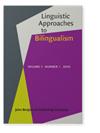双语者在两种真发声语言中产生语言特异性发声时间
IF 1.8
2区 文学
0 LANGUAGE & LINGUISTICS
引用次数: 1
摘要
众所周知,早期双语者在语音对比的语音实现上存在差异,他们具有特定于语言的发声系统。本研究调查了讲巴斯克语和西班牙语两种真正发声语言的双语者的发声分离。我们还描述了Gipuzkoan西班牙语和Gipuzkoan巴斯克语的发声系统,Gipuzkoan巴斯克语是最接近标准巴斯克语的方言,但尚未进行实验研究。20名巴斯克-西班牙早期说吉普斯科方言的双语者参加了两项图片命名任务。我们通过测量Gipuzkoan巴斯克语和西班牙语的语音开始时间(VOT)来描述他们的发声系统,并使用线性混合效应模型来研究语言之间的产生差异。我们的研究结果首次表明,说两种真正发声语言的成年早期双语者会在“发声”的爆炸式中产生特定于语言的VOT。这一发现表明,双语者在生产过程中的语音系统比之前假设的更细粒度,有助于更深入地理解早期双语语音系统的粒度。本文章由计算机程序翻译,如有差异,请以英文原文为准。
Bilinguals produce language-specific voice onset time in two true-voicing languages
It is well established that early bilinguals who speak languages that differ in the phonetic implementation of the
voicing contrast have language-specific voicing systems. This study investigates voicing separation in bilinguals who speak two
true-voicing languages, Basque and Spanish. We also describe the voicing system in Gipuzkoan Spanish and Gipuzkoan Basque, which
is the closest dialect to Standard Basque and it has not yet been investigated experimentally. Twenty Basque-Spanish early
bilingual speakers of Gipuzkoan dialects participated in two picture naming tasks. We described their voicing system by measuring
voice onset time (VOT) in both Gipuzkoan Basque and Spanish, and used linear mixed-effects models to investigate between-language
production differences. Our results show for the first time that adult early bilinguals who speak two true-voicing languages
produce language-specific VOT in ‘voiced’ plosives. This finding demonstrates that bilinguals’ phonetic systems during production
are more fine-grained than previously assumed, and contributes to a deeper understanding of granularity in early bilingual
phonetic systems.
求助全文
通过发布文献求助,成功后即可免费获取论文全文。
去求助
来源期刊

Linguistic Approaches To Bilingualism
Social Sciences-Linguistics and Language
CiteScore
3.20
自引率
9.10%
发文量
24
期刊介绍:
LAB provides an outlet for cutting-edge, contemporary studies on bilingualism. LAB assumes a broad definition of bilingualism, including: adult L2 acquisition, simultaneous child bilingualism, child L2 acquisition, adult heritage speaker competence, L1 attrition in L2/Ln environments, and adult L3/Ln acquisition. LAB solicits high quality articles of original research assuming any cognitive science approach to understanding the mental representation of bilingual language competence and performance, including cognitive linguistics, emergentism/connectionism, generative theories, psycholinguistic and processing accounts, and covering typical and atypical populations.
 求助内容:
求助内容: 应助结果提醒方式:
应助结果提醒方式:


